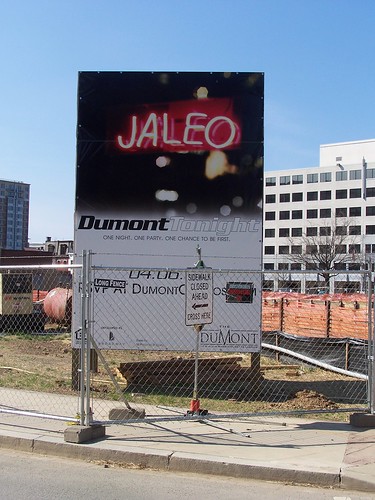Another unintended and likely negative consequence in mixed use development
 Delta Towers on the 1400 block of Florida Avenue NE. This building and its dated design contribute to negative perceptions of the Trinidad neighborhood north of the project, as well as to H Street and the surrounding areas.
Delta Towers on the 1400 block of Florida Avenue NE. This building and its dated design contribute to negative perceptions of the Trinidad neighborhood north of the project, as well as to H Street and the surrounding areas.I am getting involved in a development question in the H Street neighborhood, and along with the recent article "Mediocre Mile" from the Post, the conversation has made me think more seriously about one of the unintended consequences of adding residential development, primarily this is an issue of new construction, to formerly commercial only areas, making them mixed-use, which is something all of us committed to urban living and compact development and sustainable land use and resource planning want.
(This is drawn from an email I wrote.)
The zoning regulations don't provide for design review. It's true that there are some design regulations in the zoning overlay for H St. but they are simple, because the law doesn't really provide much guidance. Design review in all the other neighborhood commercial districts covered by a similar zoning overlay is handled by the Historic Preservation Review Board, because all the other such districts are designated historic.
Anyway, something you need to think seriously about are facades of mixed use buildings, particularly residential, in neighborhood commercial districts, because these buildings aren't likely to change, and they are likely to last.
I mention this because in commercial real estate, (1) it is not uncommon for buildings and projects to have a 10-40 year life span, after which the building is torn down and rebuilt (with a new facade) or (2) during the building's useful life it gets renovated and new skin--the facade is replaced with something more visually attractive.
I think the likelihood of multiunit residential buildings where the units are individually owned going through subsequent facade design improvements comparable in scale to that done for commercial real estate is infinitesimal. The likelihood of a couple hundred households agreeing to assess themselves tens of thousands of dollars each, to improve the visual aesthetic of the facade, is low, unless a case can be made very strongly that the investment will be equal to or less than an increase in the value of the property. Even so,I find that nimbyism of all types exists, and getting that level of consensus, especially with so much money on the line, to be extremely unlikely.
But the design of the building has tremendous impact on the quality of the surrounding built environment, as well as the property values of others. In this case, your own pecuniary interest should demand that you be concerned about this issue.

But as importantly, it means that the Zoning Commission and the Office of Planning should revisit this issue because it has significant impact on the long term quality of the built environment in so many of the mixed use neighborhoods in our city.
 Condominiums at 400 Massachusetts Avenue NW, Washington, DC. Constructed by Douglas Development, designed by Phil Esocoff. Photo by Dan Malouff.
Condominiums at 400 Massachusetts Avenue NW, Washington, DC. Constructed by Douglas Development, designed by Phil Esocoff. Photo by Dan Malouff.Index Keywords: mixed-use; mixurban-design-placemaking



1 Comments:
You have shared a valuable information through this post! Thank you!
Post a Comment
<< Home